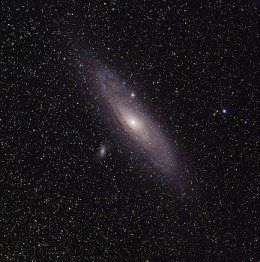So Many Surprises
- By Leslie Laney
- •
- 15 Oct, 2015
- •
Startling new discovery is Mind-Boggling

There’s been a startling new discovery about our location in the universe. I have written about the Virgo Supercluster in many of my books and used the giant galaxy M-87 as the source of many aggressive civilizations. The Milky Way is a part of this supercluster along with all the galaxies that are close it. Some of those include Andromeda, the Large and Small Magellanic clouds along with many dwarf galaxies. However, all of them are part of the larger Virgo Supercluster that appears to be revolving around a point close to M-87.
A study completed in September, 2014 has discovered that we are part of a super cluster that boggles the imagination. Instead of just two to three thousand galaxies, it’s been determined that the Virgo Supercluster is part of a giant supercluster named the Laniakea Supercluster, which has more than a hundred thousand galaxies in it. It occupies a space larger than 520 million light years across. The study concluded that all of the Superclusters contained in Laniakea shared a common point of rotation. I’ve attached an article from Wikipedia that explains what was discovered. The size and scope of this new supercluster is amazing. Note that the last line says that Laniakea is not bound together by gravity and that dark energy is expected to tear it apart in the millions of years yet to come
Wikipedia:
The Laniakea Supercluster encompasses 100,000 galaxies stretched out over 160 megaparsecs (520 million light-years). It has the approximate binding mass of 1017 solar masses, or a hundred thousand times that of our Galaxy, which is almost the same as that of the massive Horologium Supercluster. It consists of four subparts, which are known previously as separate superclusters:
- Virgo Supercluster, the part where the Milky Way resides.
- Hydra-Centaurus Supercluster
- the Great Attractor, the Laniakea central gravitational point near Norma
- Antlia Wall, known as Hydra Supercluster
- Centaurus Supercluster
- Pavo-Indus Supercluster
- Southern Supercluster, including Fornax Cluster (S373), Dorado and Eridanus clouds
The most massive galaxy clusters of Laniakea are Virgo, Hydra, Centaurus, Abell 3565, Abell 3574, Abell 3521, Fornax, Eridanus and Norma. The entire supercluster consists of approximately 300 to 500 known galaxy clusters and groups. The real number may be much larger, because some of these are traversing the Zone of Avoidance, making them essentially undetectable.
Superclusters are some of the universe’s largest structures, and have boundaries that are difficult to define, especially from the inside. The team used radio telescopes to map the motions of a large collection of local galaxies. Within a given supercluster, most galaxy motions will be directed inward, toward the center of mass. In the case of Laniakea, this gravitational focal point is called the Great Attractor, and influences the motions of our Local Group of galaxies (where our Milky Way Galaxy resides) and all others throughout our supercluster. Unlike its constituent clusters, Laniakea is not gravitationally bound and is projected to be torn apart by dark energy.[5]




